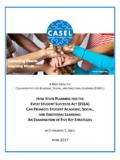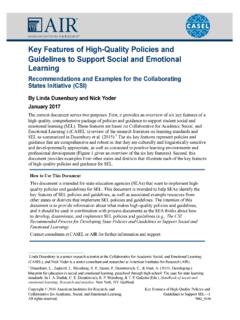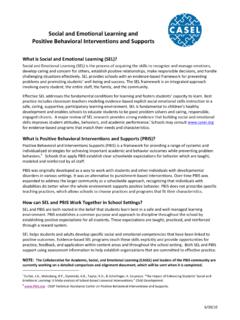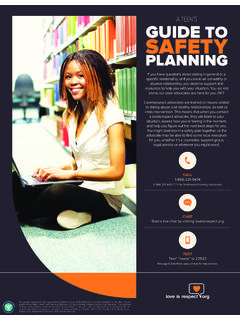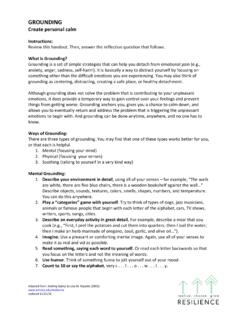Transcription of Examples of Social and Emotional Learning in Middle School ...
1 Examples of Social and Emotional Learning in Middle School Social studies Instruction Acknowledgments At the Collaborative for Academic, Social , and Emotional Learning (CASEL) generally and in the Collaborating States Initiative specifically, we believe it is important to recognize the contributions and leadership of state teams. In addition to their local responsibilities, they are joined in this collaborative effort to foster conditions for the Social and Emotional Learning for all of our students. This document could not have been produced without the insights and experience of the CASEL Collaborating States Initiative team in Massachusetts, with contributions from staff at the Massachusetts Department of Elementary and Secondary Education. Introduction Within the Collaborating States Initiative many states are developing competencies to articulate goals for what students should know and be able to do in terms of their Social and Emotional development (Dusenbury et al., 2015).
2 An immediate question from stakeholders and constituents is: How can teachers effectively promote or teach Social and Emotional competence to achieve these goals? Put another way: What do teachers and other adults need to do in the classroom and School to help students achieve the goals laid out in Social and Emotional Learning (SEL) competencies? In the past 15 years CASEL has produced three separate guides to evidence-based programs designed to promote student Social and Emotional development (CASEL, 2003; CASEL 2013; CASEL, 2015). We believe our reviews of the actual content of evidence-based programs helps inform the answers to the important question of how adults can effectively promote student SEL in the classroom and School . The purpose of this document is to draw on these previous reviews of evidence-based programs to identify and describe some of the most common strategies used to promote student SEL. Social studies and history can be enhanced when Social studies is enhanced when it is intentional about instruction and teaching practices are explicitly developing Social and Emotional Learning (SEL) core designed to promote all five core competencies of competencies.
3 Social and Emotional Learning (SEL). We know from research that curriculum and instruction that are Self-awareness. Social studies begins with an intentional about giving students the chance to awareness of self and how individuals are members develop the core Social and Emotional of their families, communities, and country. competencies of self-awareness, self-management, Self-Management. All education is based on the Social awareness, responsible decision-making, and implicit assumption that students will have the self- relationship skills significantly increase academic management skills necessary to calm themselves achievement, improve attitudes and behaviors, and focus their attention so they can effectively decrease negative behaviors, and reduce Emotional participate in Learning , including history and Social Effective Social studies and history studies . A further assumption is that students will instruction builds upon these competencies to drive have goal-setting skills to complete academic student Learning and engagement.
4 Assignments. Social Awareness. Understanding history and For example, through Social studies and History, Social studies depends on an awareness of educators can support students to: ourselves in relation to others how we may be similar and different. Understanding of history and Become more aware of themselves and their Social studies also depends on an awareness of connection to Social groups, and also to see the different cultures and historical experiences. It connections between current tasks and their provides an opportunity to understand that people personal goals and interests (self-awareness). have different perspectives based on their Develop skills for focusing attention, managing experiences. Perspective-taking is an essential part stress and anxiety, and accomplishing goals in of Social awareness. order to effectively participate in classroom Relationship Skills. Social studies may be explicitly Learning (self-management). organized to develop community service skills, Become more socially aware and develop which give students opportunities to practice respect for different cultures ( Social communication, assertiveness, conflict resolution, awareness).
5 And problem-solving. Project-based Learning and/or Collaborate in groups where they are cooperative Learning techniques also offer encouraged to consider the perspectives and opportunities for students to practice important thought processes of their peers (relationship interpersonal skills. skills). Responsible Decision-making. Social studies Reflect on choices and goals they have, and assumes that students will have the ability to demonstrated by historical figures, as a way of evaluate options and make effective decisions to developing strong decision-making skills complete assignments. Further, students have an (responsible decision-making). opportunity to reflect on the values of different historical figures, and how values and beliefs can In short, core Social and Emotional Learning motivate service to others and their community. competencies can help students to develop stronger Social studies skills and to become college and career ready. SEL in Middle School Social studies August 2017 Page 2.
6 Activities and Practices Self-Awareness Have students reflect on and discuss the different groups they belong to their family, their School community, their neighborhood community, their country and how membership in these different groups affects how they see the world. Lessons/Activities Have students reflect on and discuss or do reports on the different cultures represented in their community and similarities across groups. Use historical events to have students identify with a time they may have had the same feelings as a historical figure and ask them to discuss in small groups (or write in their journals or on an essay question) how they handled those situations. Use historical events to discuss a historical figure's feelings and how those feelings affected others and ultimately the outcome of the story. Have students complete a project to describe their cultural background and their larger community. Routinely provide authentic feedback and also ask questions that help students reflect on their own strengths and interests, , I can tell you're really enjoying this project.
7 Can you tell me what about this is making you feel so energized/motivated/happy?, I can tell you're really proud of how you did on this report/project. Can you tell me what about this you're most proud of? . Teaching Practices Routinely give students the opportunity to reflect on what they like to study or read about in history or government, what kinds of periods in history they like to learn about and why on essay questions, journal questions, or in student pair shares Tell students routinely authentic reasons why you as their teacher feel happy/optimistic for them and their future. Create class roles and responsibilities that emphasizes individual strengths, areas to improve, and personal and group goals. For example, students might be assigned the roles of taking attendance, arranging chairs, or displaying student work. Establish clear norms and consequences so students can see the impact of their own actions and behaviors on outcomes ( , create group academic projects such as a group report and help students develop appropriate strategies for providing feedback to each other if someone is not pulling his/her weight on the team).
8 SEL in Middle School Social studies August 2017 Page 3. Self-Management Teach self-management techniques such as belly breathing, yoga positions, counting to ten, self- talk, relaxation exercises, or mental rehearsal to help students develop techniques for managing stress or anxiety, including for testing or public speaking situations. Have students brainstorm ways to motivate themselves. Lead students in a discussion of how to use their awareness of emotions as a guide to decision- making. Discuss how historical figures harnessed their feelings to work for the common good. Lead a discussion that encourages students to press pause when making a decision if they are feeling angry or hurt. Help students understand that it is always better to make important decisions when we are feeling calm. Lead discussions about positive ways historical feelings expressed their feelings of oppression, anger, or disappointment. Lead a discussion about how students can express their feelings in positive ways ( , talk to an adult or friend, put our feelings into words, create media or write an essay or a journal entry about how we feel, show our feelings through dance).
9 Lessons/Activities Teach a lesson on the THINK process to help students recognize responsible use of Social media before posting an unkind or untrue remark about a person because they are upset. T is it true, H is it helpful, I is it inspiring, N is it necessary, K is it kind. Teach students a lesson how to use certain equipment (such as computers or iPads) and other resources appropriately. Use a lesson to establish rules for how equipment ( , printers or iPads) should be put away. Over the course of several weeks have students work on individual goal projects using goals they identify for themselves. Have them monitor and document their progress for several weeks. During a lesson talk about how you motivate yourself when you need to. Teach students to identify what is known about a lesson topic or objective and to identify what they need to know to understand the lesson objective, then how to set a goal to achieve it. Lead a discussion that encourages students to reflect on barriers they may encounter when completing an assignment ( , finding a computer or color printer they want to use) and that also helps them think about ways they can overcome barriers, including how to approach others for help , asking a media director for permission to use equipment.
10 Lead a discussion (ask questions) about who might be able to help, or what other resources might be available, to complete an assignment. SEL in Middle School Social studies August 2017 Page 4. Create class projects that require effort ( , complete a class writing project to develop a cookbook on favorite family recipes in the class, and have a celebration at the end , invite family to come to a celebration of the cookbook, bringing recipes), and encourage students through to their completion. Use historical events to discuss how historical figures persevered through hard times to turn their lives around or reach a goal. Teach students a lesson on procedures for class transitions and create class goals for improving the time it takes to complete them. Routinely practice self-management techniques as a regular part of the School day ( , start class with a deep breathing exercise). As a teacher, consistently model effective self-management in an age-appropriate way ( I'm feeling a little frustrated, so I'm going to stop and take a breath before I decide what to do next.)
